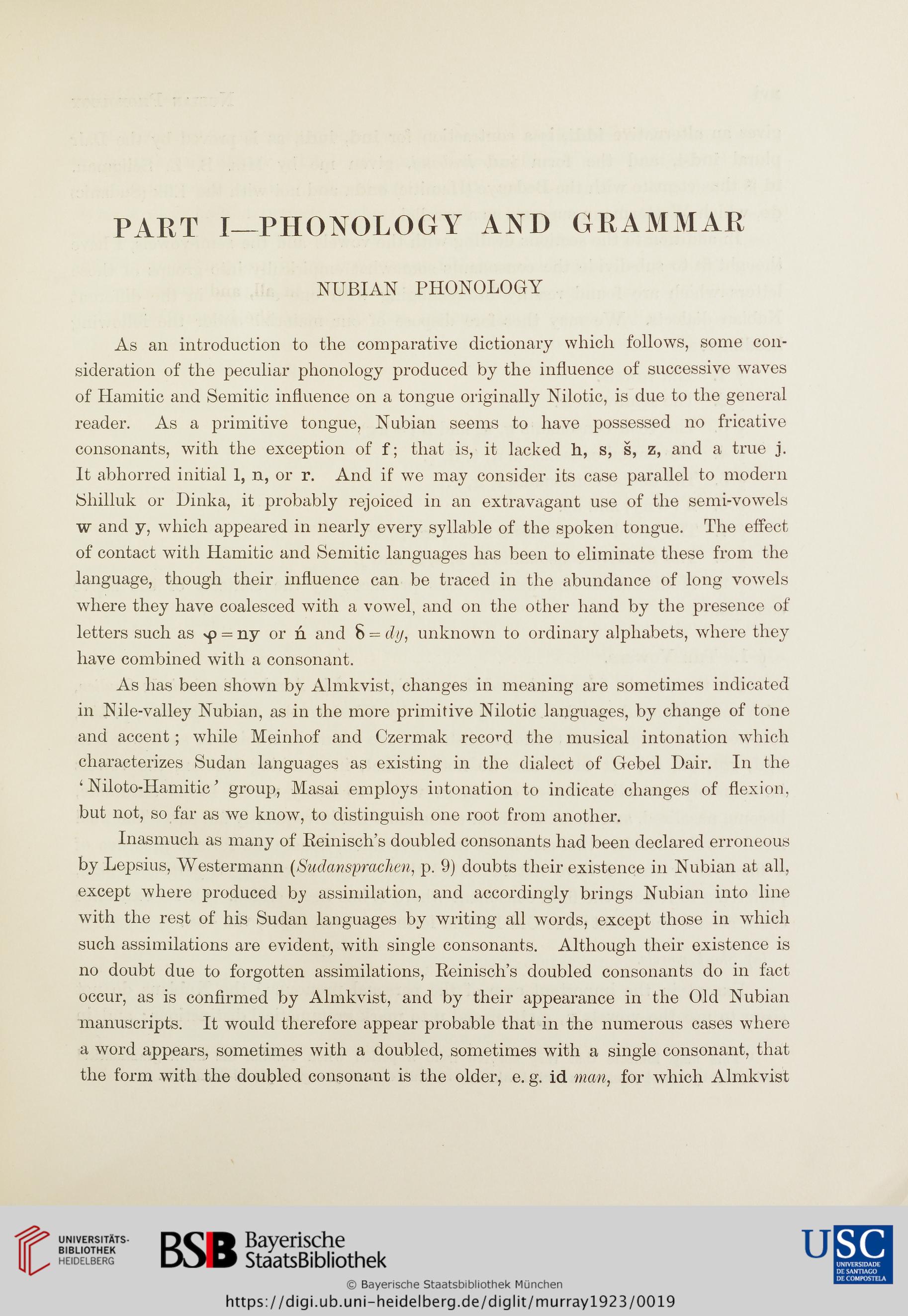PART I—PHONOLOGY AND GRAMMAR
NUBIAN PHONOLOGY
As an introduction to the comparative dictionary which follows, some con-
sideration of the peculiar phonology produced by the influence of successive waves
of Hamitic and Semitic influence on a tongue originally Nilotic, is due to the general
reader. As a primitive tongue, Nubian seems to have possessed no fricative
consonants, with the exception of f; that is, it lacked h, s, s, z, and a true j.
It abhorred initial 1, n, or r. And if we may consider its case parallel to modern
Shilluk or Dinka, it probably rejoiced in an extravagant use of the semi-vowels
w and y, which appeared in nearly every syllable of the spoken tongue. The effect
of contact with Hamitic and Semitic languages has been to eliminate these from the
language, though their influence can be traced in the abundance of long vowels
where they have coalesced with a vowel, and on the other hand by the presence of
letters such as = ny or n. and 8 = d//, unknown to ordinary alphabets, where they
have combined with a consonant.
As has been shown by Almkvist, changes in meaning are sometimes indicated
in Nile-valley Nubian, as in the more primitive Nilotic languages, by change of tone
and accent; while Meinhof and Czermak record the musical intonation which
characterizes Sudan languages as existing in the dialect of Gebel Dair. In the
1 Niloto-Hamitic ’ group, Masai employs intonation to indicate changes of flexion,
but not, so far as we know, to distinguish one root from another.
Inasmuch as many of Reinisch’s doubled consonants had been declared erroneous
by Lepsius, Westermann (Sudan sprachen, p. 9) doubts their existence in Nubian at all,
except where produced by assimilation, and accordingly brings Nubian into line
with the rest of his Sudan languages by writing all words, except those in which
such assimilations are evident, with single consonants. Although their existence is
no doubt due to forgotten assimilations, Reinisch’s doubled consonants do in fact
occur, as is confirmed by Almkvist, and by their appearance in the Old Nubian
manuscripts. It would therefore appear probable that in the numerous cases where
a word appears, sometimes with a doubled, sometimes with a single consonant, that
the form with the doubled consonant is the older, e. g. id man, for which Almkvist
NUBIAN PHONOLOGY
As an introduction to the comparative dictionary which follows, some con-
sideration of the peculiar phonology produced by the influence of successive waves
of Hamitic and Semitic influence on a tongue originally Nilotic, is due to the general
reader. As a primitive tongue, Nubian seems to have possessed no fricative
consonants, with the exception of f; that is, it lacked h, s, s, z, and a true j.
It abhorred initial 1, n, or r. And if we may consider its case parallel to modern
Shilluk or Dinka, it probably rejoiced in an extravagant use of the semi-vowels
w and y, which appeared in nearly every syllable of the spoken tongue. The effect
of contact with Hamitic and Semitic languages has been to eliminate these from the
language, though their influence can be traced in the abundance of long vowels
where they have coalesced with a vowel, and on the other hand by the presence of
letters such as = ny or n. and 8 = d//, unknown to ordinary alphabets, where they
have combined with a consonant.
As has been shown by Almkvist, changes in meaning are sometimes indicated
in Nile-valley Nubian, as in the more primitive Nilotic languages, by change of tone
and accent; while Meinhof and Czermak record the musical intonation which
characterizes Sudan languages as existing in the dialect of Gebel Dair. In the
1 Niloto-Hamitic ’ group, Masai employs intonation to indicate changes of flexion,
but not, so far as we know, to distinguish one root from another.
Inasmuch as many of Reinisch’s doubled consonants had been declared erroneous
by Lepsius, Westermann (Sudan sprachen, p. 9) doubts their existence in Nubian at all,
except where produced by assimilation, and accordingly brings Nubian into line
with the rest of his Sudan languages by writing all words, except those in which
such assimilations are evident, with single consonants. Although their existence is
no doubt due to forgotten assimilations, Reinisch’s doubled consonants do in fact
occur, as is confirmed by Almkvist, and by their appearance in the Old Nubian
manuscripts. It would therefore appear probable that in the numerous cases where
a word appears, sometimes with a doubled, sometimes with a single consonant, that
the form with the doubled consonant is the older, e. g. id man, for which Almkvist




